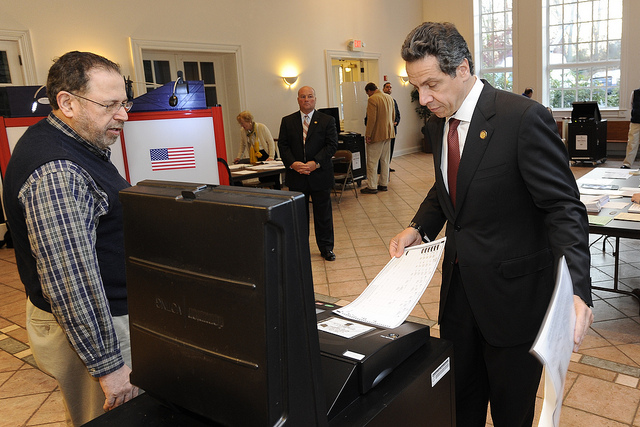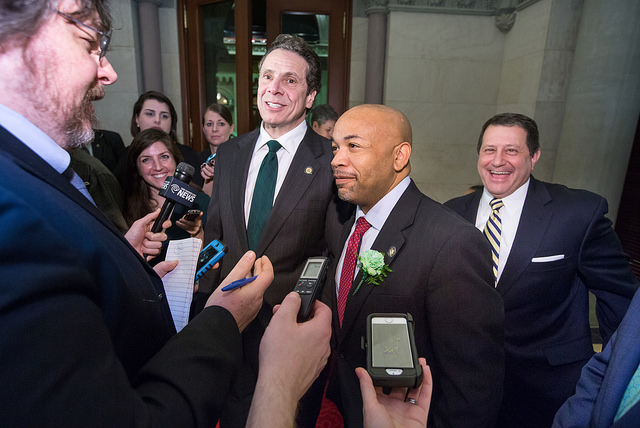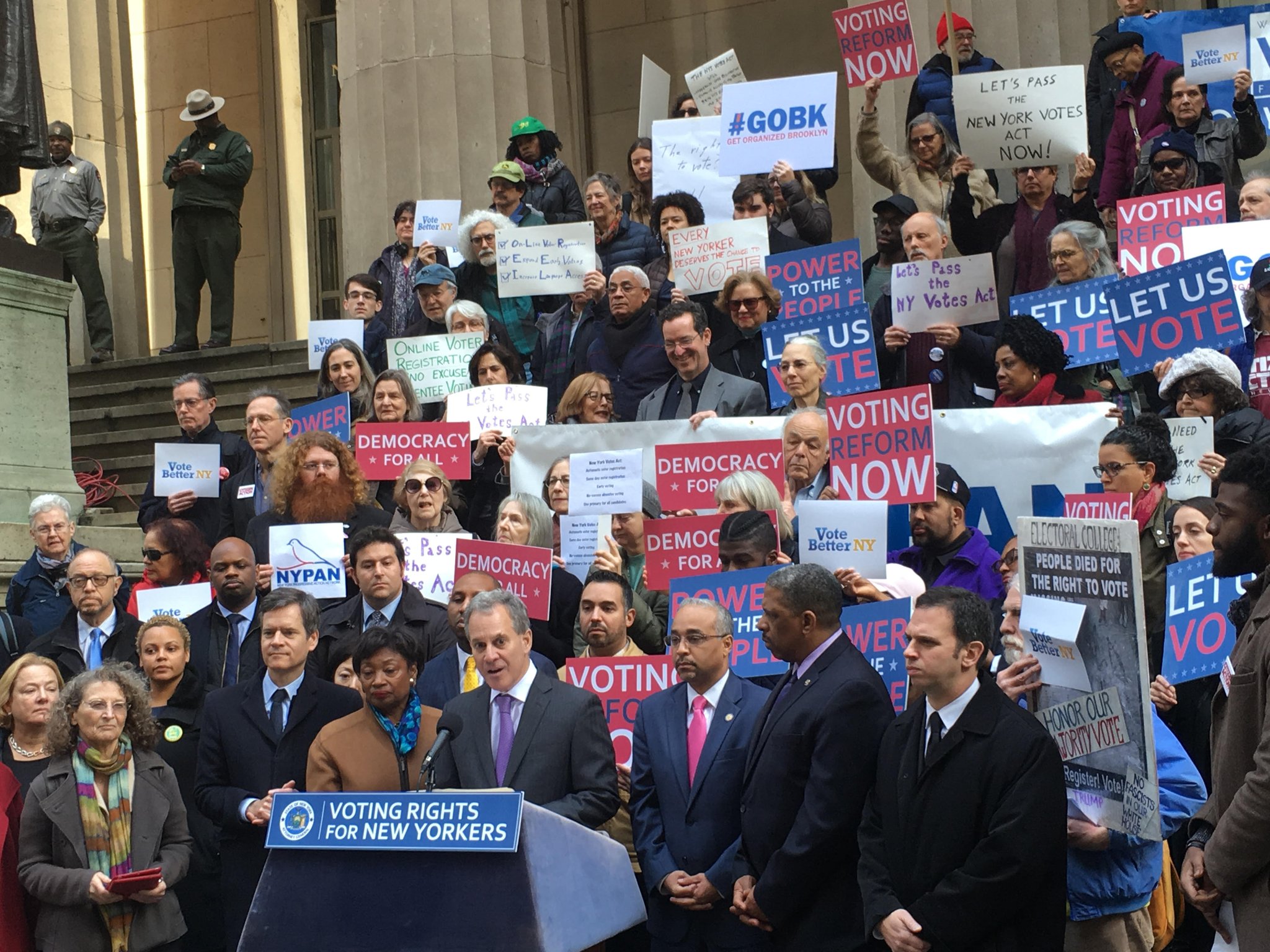The Best Way to Ensure New York Election Integrity? Modernize!

Governor Andrew Cuomo votes (photo: The Governor's Office on Flickr)
The Trump administration has made a series of unsupported claims about voter fraud that strike at the heart and integrity of our democracy. Beyond potentially undermining voters’ faith in our electoral system, these claims distract from a very real issue: New York’s voter registration system is badly in need of modernization.
Last month, President Trump repeated his unsubstantiated claim (originally tweeted in November) that as many as 5 million votes were illegally cast in the 2016 election and that an investigation would be forthcoming. Later, the White House press secretary suggested the investigation could focus on states where the Trump campaign did not invest significant resources, like California and New York (which Hillary Clinton won by a margin of 1.74 million votes). Then on Feb. 5, the administration announced that Vice President Mike Pence would head an investigative commission into 2016 voter fraud.
Let’s look at the basic evidence about these explosive claims.
First, election administrators from around the country say there is no evidence to support White House claims about the 2016 elections. Here in New York City, the executive director of the Board of Elections recently told the City Council that he was not aware of any voter fraud in the city.
The reality is that in-person voter fraud is virtually nonexistent. Numerous studies of the issue have shown only a handful of instances where fraudulent ballots were cast. One such study of more than 1 billion votes cast found exactly 31 incidents of voter fraud, a rate of less than 0.00001 percent.
Under former President George W. Bush, the attorney general instructed the Department of Justice to investigate voter fraud. After five years, U.S. Attorneys did not uncover any organized voter fraud effort and brought only about 100 successful prosecutions, many stemming from individuals who “mistakenly filled out registration forms or misunderstood eligibility rules.” Even states that have attempted noncitizen voter purges or aggressively pursued criminal investigations have been unsuccessful at uncovering anything more than isolated instances of unlawful voting. (It is worth noting that Senate Majority Leader Mitch McConnell has indicated he will not support funding an investigative commission because he has not seen sufficient evidence that fraud occurred.)
Despite this absence of evidence, lawmakers in some states have used voter fraud claims as a pretext to restrict voting access.
Another key element of the administration’s claims is the phenomenon of “double registration,” which occurs when a voter is registered in two (or more) states. Though it is illegal to cast multiple ballots, being registered to vote in two states is not illegal. In fact, double registration is fairly common: a 2008 Pew study found that one in eight voter registrations are inaccurate or invalid. This is because people often move or buy property in different states, such as when college students register in the state where their school is located.
The 1993 National Voter Registration Act requires states to maintain current and accurate lists and includes important safeguards to protect voters from erroneous removal. To maintain up-to-date lists, election administrators compare the voter rolls to other government data maintained by the Social Security Administration and the Post Office. More recently, states have begun comparing their rolls against lists in other states through exchanges like the Electronic Registration Information Center (ERIC), a practice endorsed by the Presidential Commission on Election Administration.
Some states are making strides to update their technology to get more eligible citizens onto the voter rolls and to keep the rolls accurate, but New York’s system is woefully out-of-date. Our paper-based system leads to typos, names missing from the poll books, and other errors which prevent eligible voters from casting a ballot that counts. Even worse, hundreds of thousands of voters have been illegally purged from the rolls, stripping those New Yorkers of their voting rights.
This is a moment for New York to take leadership on voting rights and use technology to increase access to the ballot. Common-sense reforms like the Voter Empowerment Act, or the New York Votes Act that was introduced by Attorney General Eric Schneiderman last week, would ensure that every voter can easily register and participate in our elections. Modernizing our voter registration system is the best way to ensure the integrity of our elections – not another search for voter fraud that experts and experience tell us does not exist.
***
Amy Loprest is executive director of the New York City Campaign Finance Board and the city’s NYC Votes voter engagement campaign.
***
Have an op-ed idea or submission for Gotham Gazette? Email This email address is being protected from spambots. You need JavaScript enabled to view it.
Beware of 'Common Sense' Arguments Against the Millionaire's Tax

Assembly Speaker Carl Heastie (photo: The Governor's Office)
Higher taxes on New York’s wealthy are on the table in three places for this year’s budget negotiations. Governor Andrew Cuomo’s Executive Budget for 2018 includes an extension of the so-called "millionaire’s tax”. The state Assembly has decided to see the governor and raise him with their proposed “gazillionaire’s tax”, while Mayor de Blasio has proposed a “mansion tax”.
The Democratic-controlled Assembly favors them all. The Republicans, who control the state Senate, are against all three. But the governor exerts a great deal of control over the New York State budget process and holds most of the cards. And while the governor is the one proposing the extension of the millionaire’s tax, he doesn’t appear to support the others. So is there any reason for progressives to believe that the mansion tax, let alone the gazillionaire’s tax, might pass now?
For starters, taxes on the wealthy are broadly popular with voters. Just like raising the minimum wage, even Republican voters tend to favor these types of taxes, as do the wealthy themselves irrespective of party affiliation. A recent Siena Poll showed New Yorkers in favor of extending the millionaire’s tax by a margin of 74 percent to 23 percent, with 61 percent of Republicans on board along with 81 percent of Democrats.
On the other hand, Republicans are offering arguments that have worked before. They say that New York is already over-taxed, and that taxes on the high earners will just drive them to leave the state and take their job-creating business with them. Corporate-backed “non-partisan” groups take the same position, as Governor Cuomo often does as well.
If Republicans can be said to believe in just one thing, it is that progressive tax policies will drive the rich away and impoverish all who remain, bereft of “job creators”. From Ayn Rand and Galt’s Gulch, to Ronald Reagan and the Laffer Curve, to ALEC and Stephen Moore today, the argument that higher taxes will make the rich work less or move to some promised land of lower taxes is one of the most consistent pieces of Republican philosophy. But are any of their arguments actually grounded in observable reality?
Republicans rarely cite any empirical research to back their claims. Why should they when it’s just “common sense”? But does reality back up the “common sense” of the GOP? The answer is definitively “no”.
Study after study after study has shown no significant pattern of wealthy people moving from high-tax to low-tax states, and no noticeable change in the net migration rates of high earners between US states in the wake of changes in their relative tax rates. And there is no evidence that either hours worked or income earned by high earners overall is reduced meaningfully by higher tax rates.
Republicans can always find anecdotal evidence that high taxes will drive or are driving the rich from high to low-tax states. But one rich person who moves from Manhattan to Miami proves nothing. All kinds of people, rich and poor, move from New York to Florida every year. And all kinds of people move from Florida to New York. The net effect is tiny, and made up for by people moving to New York from other states and other countries.
New York’s millionaire’s tax first passed in 2009. As you can see here, here, here and here, the primary argument used against it was that rich people were going to move. And when the millionaire’s tax was renewed in 2011, the same arguments were made, including by Governor Cuomo himself.
With the better part of a decade’s worth of data, were the “common sense” mongers of the Right actually correct? No, no and no. New York’s rich haven’t flown off to lower tax states. Property values at the upper end of the New York real estate market have risen unabated. All their warnings have come to naught.
So Assembly Speaker Carl Heastie and Assemblymember Herman Farrell, armed with observable fact and measurable experience, have introduced the gazillionaire’s tax. It extends the logic of the millionaire’s tax with a series of four additional tax brackets starting at $5,000,000 and adding at most 1.5 percentage points of incremental tax on incomes over $100,000,000 per year. That’s not a typo, and yes there are multiple households in New York with annual incomes above $100,000,000, and former Mayor Michael Bloomberg’s isn’t the only one.
The objections to the gazillionaire’s tax are no different than the objections to the millionaire’s tax, and they are just as certain to be completely wrong in the real world. Republican arguments against higher taxes are premised in deeply faulty views of both human nature and economics. The richest of the rich don’t wake up every morning and say, “Hmmm, I will work today if my tax rate is 47 percent, but I will go back to sleep or move to Florida if it’s 48.5 percent.” We are talking about people who could never spend all of the money they have already earned. They keep working as hard as they do for a variety of reasons, like relative success, prestige, and actual enjoyment in their work, with take-home pay being just one item on a long list.
Arguments against the mansion tax are essentially the same but even weaker. They don’t even have “common sense” to fall back on. Where’s the common sense in stating that a 2.5 percent tax surcharge on proceeds in excess of $2 million will have any effect on home sales? Are people not going to move when it’s time to move because of it? Of course not. It’s just a wealth tax applied on a transactional basis.
Massive, long-term, structural trends -- trends that many Trump voters are incidentally rebelling against -- have been and will continue to drive the relative success of America’s, and the world’s, largest and strongest cities. Clusters of like-minded people, of competitive college graduates from all over the country and the world, will continue to grow and prosper. “Trends” that major industries, like financial services, are going to move to low-tax states are perennially flogged by the Right. But they never actually happen.
So the next time you hear someone say, “You can’t raise taxes on the rich in New York, they already pay too much and they’ll just move to Texas or Florida; it’s just common sense”, you should say, “Yes we can raise taxes on the richest New Yorkers, all of the data over many years and many studies has shown definitively that they aren’t going anywhere, so you can stick your common sense in a hot, humid, boring low-tax state with low-wage jobs.” Now that’s just common sense.
***
Gus Christensen is a financial consultant to non-profits and start-ups, as well as a former investment banker and political candidate.
***
Have an op-ed idea or submission for Gotham Gazette? Email This email address is being protected from spambots. You need JavaScript enabled to view it.
AG Schneiderman Should Improve Our Democracy by Supporting Open Primaries

Attorney General Schneiderman (photo: @AGSchneiderman)
Last week, Attorney General Eric Schneiderman stood before a crowd of New Yorkers gathered at Federal Hall and announced the introduction of a comprehensive reform bill aimed at expanding voting rights in New York. I applaud his leadership on this issue but he misses a critical point.
New York has some of the worst elections laws in the country. Among other backwards anti-voting provisions, New York has no early voting (unlike 37 states), a partisan board of elections, excuse-only absentee balloting, antiquated voting systems and holds multiple primary elections on different dates. Voters had to change their party registrations more than a full six months before the April 2016 presidential primary, before all the candidates were even identified.
The massive impediment to voting in New York is not administrative and it is by no means passive; it’s the intentional denial of the voting rights of 3.2 million independent and third-party New Yorkers because of our system of closed primaries, in which only registered voters from the two main political parties can cast a ballot for their party’s candidate. To put that in perspective, that is half a million more voters than are registered with the Republican Party in New York. It's also more than the total number of registered voters in the entire states of Vermont, North Dakota, South Dakota, Delaware, and Montana combined. Why does New York State believe that it has the right to dictate its citizens’ conscience?
Like those 3.2 million other independently minded New Yorkers, I am denied my basic rights as a citizen in our democracy. I was shut out of the 2016 primary elections, one of the most consequential elections in my lifetime. Why? Because I chose not to join a political party in order to exercise my right to vote. That’s not right and the 2016 primary elections perfectly illustrate why. On October 9, 2015 (the date by which New Yorkers had to change their registrations in order to vote in the primaries), few had heard of Bernie Sanders and even fewer believed that Donald Trump would become the Republican party nominee. By April, both had gained popular support among their party's voters and energized the electorate, many of whom could not cast their ballots for them. These facts demonstrate that the ability to vote in a primary is far more significant than the ability to vote in a general election.
New York’s primary elections are not simply private party nominating contests, a deceit that is often used to justify voter disenfranchisement, and which intentionally obfuscates the fact that primaries are publicly run and paid for with millions of dollars of taxpayer money. New York’s primary elections are administered in public buildings and run by publicly paid for employees on publicly owned machines. They differ from the general election in one key respect only, that they exclude 3.2 million voters and prevent millions more major party voters from exercising real choice in voting.
It’s no wonder New York has one of the lowest voter turnout rates in the country. Only 19.7 percent of registered New Yorkers cast a ballot in last April’s presidential primary, the second-lowest voter turnout among primary states after Louisiana. I fully support the attorney general’s work to improve our system of voting in New York, but how can we have a serious conversation about voting rights in New York when we ignore the fact that currently in New York, 33 percent of millennial voters, 33 percent of Asian voters, 20 percent of Latino voters and 15 percent of African-American voters who don’t belong to one of the two major political parties are shut out of voting in primary elections.
Accordingly, I brought a lawsuit challenging New York’s failing system of primary elections. While my lawsuit does not directly challenge New York’s closed primary system (because I believe that discrete question is one for the legislature), it does specifically challenge the constitutionality of that provision of the election law requiring a change of party affiliation more than six months in advance of a primary election – likely at a point in time when a voter will not have had any meaningful opportunity to make up her mind. If the right to vote is to mean anything, that right must be meaningful. While the attorney general is my opponent in these proceedings, he fully supports jettisoning the provision of the election law that I challenged, and essentially recognizes its unconstitutionality. Ironically, AG Schneiderman’s first public announcement of his voting reforms took place on December 6, 2016 at the very same moment – literally – that his office was opposing my efforts to open the system up.
Nonetheless, in his remarks last week, the Attorney General said that more people voting is good for our political parties and that anything that expands voting rights is a good thing. I agree, and encourage him to embrace open primaries and further open our democracy in New York State.
It is not debatable that every eligible New Yorker should have the right to vote for who they want in every election.
***
Mark Moody is a New York City-based attorney in private practice.
***
Have an op-ed idea or submission for Gotham Gazette? Email This email address is being protected from spambots. You need JavaScript enabled to view it.




